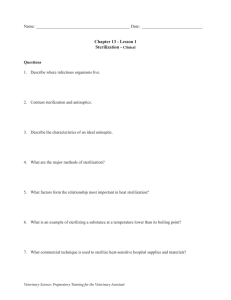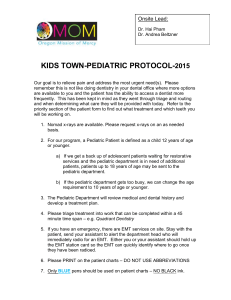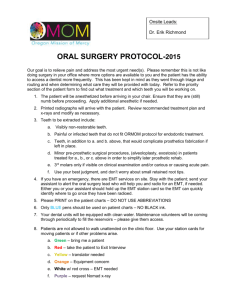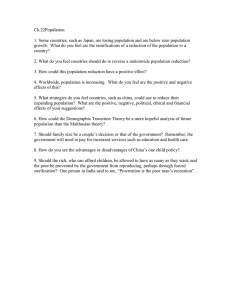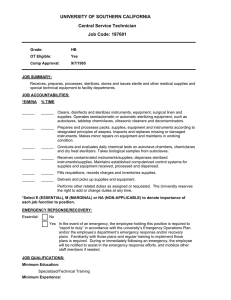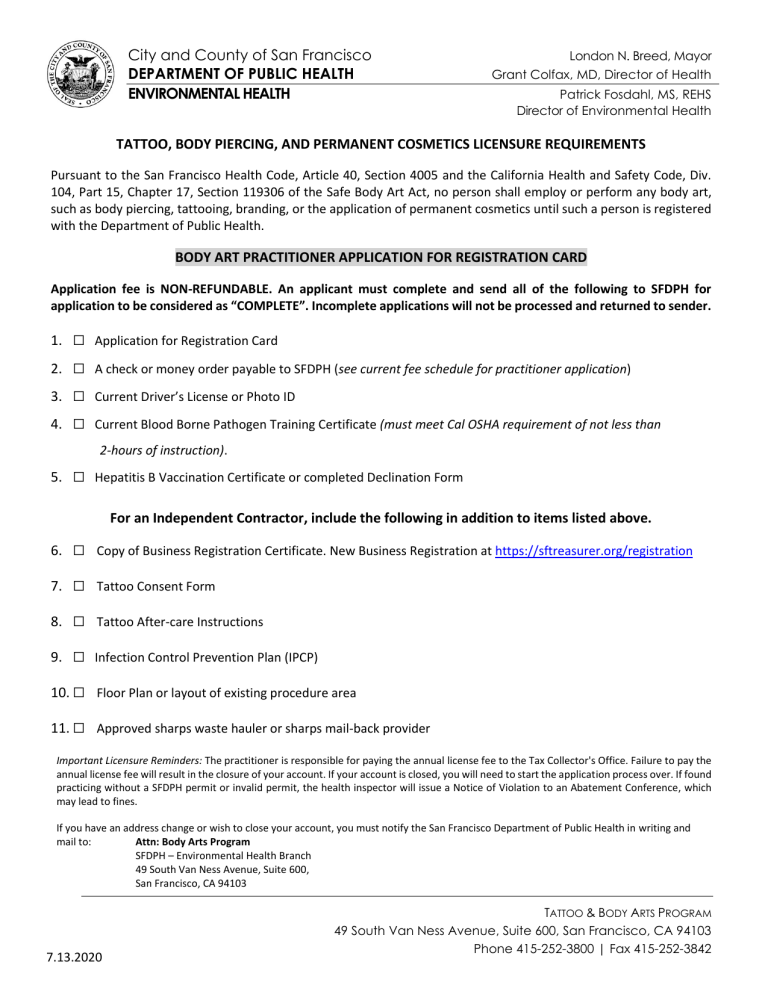
City and County of San Francisco DEPARTMENT OF PUBLIC HEALTH ENVIRONMENTAL HEALTH London N. Breed, Mayor Grant Colfax, MD, Director of Health Patrick Fosdahl, MS, REHS Director of Environmental Health TATTOO, BODY PIERCING, AND PERMANENT COSMETICS LICENSURE REQUIREMENTS Pursuant to the San Francisco Health Code, Article 40, Section 4005 and the California Health and Safety Code, Div. 104, Part 15, Chapter 17, Section 119306 of the Safe Body Art Act, no person shall employ or perform any body art, such as body piercing, tattooing, branding, or the application of permanent cosmetics until such a person is registered with the Department of Public Health. BODY ART PRACTITIONER APPLICATION FOR REGISTRATION CARD Application fee is NON-REFUNDABLE. An applicant must complete and send all of the following to SFDPH for application to be considered as “COMPLETE”. Incomplete applications will not be processed and returned to sender. 1. ☐ Application for Registration Card 2. ☐ A check or money order payable to SFDPH (see current fee schedule for practitioner application) 3. ☐ Current Driver’s License or Photo ID 4. ☐ Current Blood Borne Pathogen Training Certificate (must meet Cal OSHA requirement of not less than 2-hours of instruction). 5. ☐ Hepatitis B Vaccination Certificate or completed Declination Form For an Independent Contractor, include the following in addition to items listed above. 6. ☐ Copy of Business Registration Certificate. New Business Registration at https://sftreasurer.org/registration 7. ☐ Tattoo Consent Form 8. ☐ Tattoo After-care Instructions 9. ☐ Infection Control Prevention Plan (IPCP) 10. ☐ Floor Plan or layout of existing procedure area 11. ☐ Approved sharps waste hauler or sharps mail-back provider Important Licensure Reminders: The practitioner is responsible for paying the annual license fee to the Tax Collector's Office. Failure to pay the annual license fee will result in the closure of your account. If your account is closed, you will need to start the application process over. If found practicing without a SFDPH permit or invalid permit, the health inspector will issue a Notice of Violation to an Abatement Conference, which may lead to fines. If you have an address change or wish to close your account, you must notify the San Francisco Department of Public Health in writing and mail to: Attn: Body Arts Program SFDPH – Environmental Health Branch 49 South Van Ness Avenue, Suite 600, San Francisco, CA 94103 7.13.2020 TATTOO & BODY ARTS PROGRAM 49 South Van Ness Avenue, Suite 600, San Francisco, CA 94103 Phone 415-252-3800 | Fax 415-252-3842 City and County of San Francisco DEPARTMENT OF PUBLIC HEALTH ENVIRONMENTAL HEALTH BRANCH TATTOOING, BODY PIERCING, AND PERMANENT COSMETICS APPLICATION FOR REGISTRATION CARD The San Francisco Tattooing, Body Piercing, Permanent Cosmetics Ordinance requires persons or businesses that are engaged in the practice of tattooing, body piercing or permanent cosmetics to have an information document on-site and on-file with the Department of Public Health. An application will not be accepted until all applicable forms are completed and returned with the appropriate fee. 1. GENERAL PRACTITIONER INFORMATION FULL LEGAL NAME (List alias in parenthesis if applicable) HOME ADDRESS (Is this your mailing address? Yes HOME OR CELLPHONE NUMBER EMAIL ADDRESS CITY No) STATE ZIP CODE TYPE OF SERVICE PROVIDED: Tattoo Body Piercing Permanent Cosmetics Apprentice LIST ALL ESTABLISHMENTS WHERE YOU CURRENTLY OR INTEND TO ENGAGE IN THE PRACTICE OF TATTOOING, BODY PIERCING OR THE APPLICATION OF PERMANENT COSMETICS. FACILITY NAME STREET ADDRESS (Is this your mailing address) FACILITY NAME STREET ADDRESS BUSINESS PHONE NUMBER FACILITY NAME STREET ADDRESS BUSINESS PHONE NUMBER 2. Yes No) BUSINESS PHONE NUMBER HEPATITIS B VACCINATION AND EXPOSURE CONTROL TRAINING STATE LAW REQUIRES THAT EACH PRACTITIONER RECEIVE HEPATITIS B VACCINATION OR FILE A CERTIFICATE OF DECLINATION OF HEPATITIS B VACCINATION WITH THE FACILITY OWNER/OPERATOR AND THE SAN FRANCISCO DEPARTMENT OF PUBLIC HEALTH. Yes No Have you received a Hepatitis B (HBV) vaccination? Do you have documentation? Documentation is either a certificate of completion of vaccination or laboratory Evidence. Please provide a copy of the documentation. If you have not received a HBV vaccination, have you supplied the facility owner/operator with certification of HBV declination? Have you received exposure control training (infection control/blood-borne pathogens)? If so, where and when? EHS Office Use Only District Census Tract PE Tax Account # Employee # Cert Type Certificate # TATTOOING, BODY PIERCING, AND PERMANENT COSMETICS APPLICATION FOR REGISTRATION CARD Page 2 of 2 3. EXPERIENCE AND TRAINING BRIEFLY DESCRIBE YOUR EXPERIENCE, TRAINING AND QUALIFICATIONS (Include dates and locations): I am the person responsible for the implementation, administration and operation of the activities required to meet the requirements of the Tattooing, Body Piercing and Permanent Cosmetics Ordinance, including reporting of information for this application. I declare under penalty of perjury the information on this application and in other materials submitted in support of this application are true and correct. I hereby consent to all necessary inspections made pursuant to the Tattooing, Body Piercing and Permanent Cosmetics and incidental to the issuance of any exemption, Registration or Permit, and operation of this business. I understand that submittal of incorrect information may result in penalties and a site investigation fee. PRINT NAME SIGNATURE DATE FOR OFFICE USE ONLY Special Notes Out of Business Notification Filing Fee INSPECTOR’S REPORT To the Director of Public Health – After having made a careful review of the above case on , 2 I RECOMMEND the issuance of a New Registration Card I DISAPPROVE the issuance of a New Registration Card PRINCIPAL INSPECTOR for the following reasons: INSPECTOR City and County of San Francisco DEPARTMENT OF PUBLIC HEALTH ENVIRONMENTAL HEALTH London N. Breed, Mayor Grant Colfax, MD, Director of Health Patrick Fosdahl, MS, REHS Director of Environmental Health Hepatitis B Vaccine Declination Form Appendix A to Section 1910.1030 --- Hepatitis B Vaccine Declination (Mandatory) (HIPAA Protected) I understand that due to my occupational exposure to blood or Other Potentially Infectious Materials (OPIM) I may be at risk of acquiring the Hepatitis B Virus (HBV) infection. I have been given the opportunity to be vaccinated with Hepatitis B vaccine, at no charge to myself. However, I decline the Hepatitis B vaccination at this time. I understand that by declining this vaccine, I continue to be at risk of acquiring Hepatitis B, a serious disease. If in the future I continue to have occupational exposure to blood or other potentially infectious materials and I want to be vaccinated with Hepatitis B vaccine, I can receive the vaccination series at no charge to me. Applicant: Date: __________________________________________ Printed Name: __________________________________ Signature: ______________________________________ Employer: Date: __________________________________________ Printed Name: __________________________________ Signature: ______________________________________ CONSUMER PROTECTION 7.13.2020 49 South Van Ness Avenue, Suite 600, San Francisco, CA 94103 Phone (415) 252-3800 Fax (415) 252-3842 City and County of San Francisco DEPARTMENT OF PUBLIC HEALTH ENVIRONMENTAL HEALTH London N. Breed, Mayor Grant Colfax, MD, Director of Public Health Patrick Fosdahl, MS, REHS Director of Environmental Health Bloodborne Pathogen (BBP) Training Courses* BloodBorne Pathogen (BBP) training which meets Cal/OSHA's Bloodborne Pathogens Standard 8 CCR 5193 is required for persons who may be exposed to BBP while performing their routine work functions. This includes, but not limited to: tattoo artists, permanent cosmetics professionals, and body piercers. Additionally, Cal/OSHA and The Safe Body Art Act (AB 300) requires that the training and training material must be specific to performing body art. BBP training contact time must meet a minimum of 2 hours. Training must be renewed annually. Records must be kept for a minimum of 3 years. Should a class be taken that does not meet these requirements, SFDPH will require that another training class be taken following the same requirements. Above Training, Inc. California Bloodborne Pathogens Training for Body Arts (801) 494-1416 www.abovetraining.com/bbp.php Biologix Solutions LLC Online: Bloodborne Pathogens for California Body Art (816) 242-0045 https://blxtraining.com/tattoopiercing-bbp/ Body Art Training Group (858) 792-1630 https://www.yourtrainingplace.com/courses BloodBorne Pathogen Prevention Training Institute of America (805) 458-7809 http://www.bbptraining.com/ Cathy Montie’s Body Art Training Company (619) 303-5893 http://www.cathymontie.com/classes-bbp-usa.php Eduwhere Bloodborne Pathogen Training (866) 523-9108 http://www.eduwhere.com/courses.php Pro Training: Bloodborne Pathogens (818) 406-7487 https://www.protrainings.com/en/courses/274-california-compliant-bloodborne-for-body-art?topic_id=2 Industry Specific BBP Training Lee A. Ballesteros 804 West 3rd Street Antioch, CA 94509 (925) 778-9069 contactLeeB@gmail.com Health and Safety Classes OSHA Authorized Instructor: Maria Kian (916) 996-3435 http://healthandsafetyclasses.com/ Society of Permanent Cosmetics Professional (847) 635-1330 https://www.spcp.org/ Alliance of Professional Tattooists, Inc. (520) 514-5549 http://www.safe-tattoos.com/ Association of Professional Piercers Online https://www.safepiercing.org/online_courses.php *Please be advised that inclusion on this list is in no way to be considered an endorsement of the training provided. The providers on this list are not affiliated with the City and the City does not endorse one of provider over the others. TATTOO & BODY ARTS PROGRAM 49 South Van Ness Avenue, Suite 600, San Francisco, CA 94103 Phone 415-252-3800 | Fax 415-252-3894 Body Art Facility Infection Prevention And Control Plan Guideline In accordance with the California Health and Safety Code, Section 119313, a body art facility shall maintain and follow a written Infection Prevention and Control Plan, provided by the owner or established by the practitioners, specifying procedures to achieve compliance with the Safe Body Art Act. A Copy of the Infection Prevention and Control Plan shall be filed with the Local Enforcement Agency and a copy maintained in the body art facility. The body art facility owner shall provide onsite training on the facility’s Infection Prevention and Control Plan to the body art practitioners and employees or individuals involved with decontamination and sterilization procedures. Training shall be provided when tasks where occupational exposures may occur are initially assigned, anytime there are changes in the procedures or tasks and when new technology is adopted for use in the body art facility, but not less than once each year. Records of training shall be maintained on-site for three years. The Infection Prevention and Control Plan shall be maintained current and updated whenever there are changes to any of the procedures or tasks listed and when new technology is adopted for use in the facility. Name of Body Art Facility: Site Address: City, State, ZIP: Type of Body Art Facility: Contact Person: Page 1 of 11 Telephone: Body Art Facility Infection Prevention And Control Plan Guideline A. Decontamination and Disinfection: Describe the procedures for decontaminating and disinfecting of workstation and surfaces (California Health and Safety Code 119308 (b) and 119309 (a)(b)(c)(d)(e)). 1. Workstation surfaces/counter tops: 2. Workstation chairs/stools: 3. Trays: 4. Armrests: 5. Headrests: 6. Procedure area: 7. Tables: Page 2 of 11 Body Art Facility Infection Prevention And Control Plan Guideline 8. Tattoo machine and Clip Cord: 9. Reusable instruments, calipers, needle tubes, etc. portable light fixtures or other: 10. Permanent Cosmetic Machine: B. Reusable Instruments or Disposable: Describe the procedures used for decontaminating, sterilizing, packaging and storing of reusable instruments. Include the procedures for labeling of sterilized peel-pack. Indicate whether the body art facility uses all pre-sterilized, single-use and disposable instruments. Describe the record keeping logs and procedure logs maintained on-site when using 100% pre-sterilized, single-use and disposable instruments (California Health and Safety Code 119309 and 119315). 1. Needle tubes: 2. Calipers: 3. Other instruments: Page 3 of 11 Body Art Facility Infection Prevention And Control Plan Guideline C. Storage: Describe the storage location and equipment used for the storage of clean and sterilized instrument peel packs to protect the packages from exposure to dust and moisture (California Health and Safety Code 119315 (c)). D. Set Up and Tear Down of Workstation: Describe the procedure for setting up and tearing down the workstation for the following procedures (California Health and Safety Code 119308, 119309 (c), 119311, and 119313 (b)(4)). 1. Tattoo: 2. Piercing: 3. Permanent Cosmetics: 4. Branding: E. Prevention of Cross Contamination: Describe the techniques used to prevent the contamination of instruments, tattoo machines, trays, tables, chairs, clip cords, power supplies, squeeze bottles, inks, pigments, lamps, stools, soaps, procedure sites and additional areas of potential contamination during body art procedures. Include barriers provided to prevent cross contamination. Describe how procedure sites are prepared for a body art procedures. (California health and Safety Code 119308, 119309, and 119311 (c)(d)(e)(f)). Page 4 of 11 Body Art Facility Infection Prevention And Control Plan Guideline E. Prevention of Cross Contamination (Continued): F. Sharps Containers: Describe the procedures used for the safe handling of sharps and indicate the location of the in-use sharps containers. Indicate disposal frequency for sharps waste (California Health and Safety Code 119314 (e)). G. Sharps Disposal: Describe the disposal of sharps used during a body art procedure (California Health and Safety Code 119308 (b)(3) and 119311 (g)). 1. Needles and needle bars: 2. Razors: 3. Other sharps or single-use marking pens used on open skin: H. List the Medical Waste Hauler, Mail-back System or Alternative Treatment Technology used for the disposal of sharps containers (California Health and Safety Code 119314 (e)): Medical Waste Hauler: Street Address: City, State, ZIP: Page 5 of 11 Body Art Facility Infection Prevention And Control Plan Guideline I. Sterilization of Jewelry: Describe the procedure used for the sterilization of jewelry prior to placing into newly pierced skin (California Health and Safety Code 119310 (a) and 119315). J. Sterilization room: Describe the procedure used for decontaminating instruments prior to placing them into the autoclave. Indicate whether instruments are manually washed or machine washed, such as with an Ultrasonic machine. Describe the material used for soaking dirty instruments in the machine, such as Tergazyme (California Health and Safety Code 119309 (b)(e)(g). 119314 (c), and 119315 (b)). K. Disinfection Products: List the disinfectant products used at the body art facility (California Health and Safety Code 119301 (k) and 119308 (b)(6)). L. Time and Temperature: List the temperature of the autoclave and duration of time at that temperature required for the sterilization of clean instruments. Indicate where the sterilization log is maintained on-site. Indicate whether each sterilization load is tested using Class 5 integrators (California health and Safety Code 119315 (b)(3)(5)). Time: Temperature: Psi: M. Personal Protective Equipment: List the personal protective equipment used during a body art procedure for the practitioner and the client (California Health and Safety Code 119308 (a) and 119309 (j)). N. Handwashing Sink: List the locations of the handwash sinks and describe the items supplied at each sink (California Health and Safety Code 119314 (b)(3)). Page 6 of 11 Body Art Facility Infection Prevention And Control Plan Guideline O. Aftercare Procedure: Describe the written recommendation and care information provided to the client after a body art procedure. List the type of bandages or wrapping provided after a body art procedure (California Health and Safety Code 119309 (a)(b)(c)). P. Procedure for an Accidental Spill: Describe the clean-up and disinfection procedure taken when there is an accidental spill of sharps (California Health and Safety Code 119309 (a)(b)(c)). Q. Trash Receptacles and Disposal of Contaminated Trash: List the type of trash receptacles used and their location throughout the body art facility. Describe the procedure for the disposal of contaminated items, such as gloves (California Health and Safety Code 119311 (a) and 119314 (d)). R. Negative/Failed Spore Test: Describe the procedure conducted when a monthly spore test has failed. Indicate where the facility maintains a spore test log on-site (California Health and Safety Code 119315 (b)(2)(4)). S. Commercial Ink or Pigment Manufacturers: List the manufacturer(s) for the inks or pigments used at the facility. Describe the procedure for dilution of inks. Only sterile water should be used for dilution of inks or pigments (California Health and Safety Code 119311 (b)(c)(d)(e)). Page 7 of 11 Body Art Facility Infection Prevention And Control Plan Guideline T. Permanent Cosmetic Machine Name and Manufacturer: Provide the model name and number for the permanent cosmetic machine(s) used (California Health and Safety Code 119311 (i)(j)). U. Service Animals: Describe the facility’s policy regarding service animal presence in procedure, decontamination, and sterilization areas (California Health and Safety Code 119314 (f)). Maintain a copy of this completed document in your files. Submit one copy to the Local Enforcement Agency. I hereby certify that all body art practitioners performing body art at this facility and employees or individuals involved with decontamination and sterilization procedures have been trained with the procedures and information contained in this document. To the best of my knowledge and belief, the statements made herein are correct and true. Signature: Title: Page 8 of 11 Date: Sterilization Procedures When a body art facility is equipped with a decontamination and sterilization room and will be sterilizing reusable instruments and body art jewelry, the following sterilization procedures must be followed: 1. Clean instruments to be sterilized shall first be sealed in peel-packs that contain either a sterilizer indicator or internal temperature indicator. The outside of the pack shall be labeled 2. Sterilizers shall be loaded, operated, decontaminated and maintained according to manufacturer’ directions, and shall meet all of the following standards: • Only equipment manufactured for the sterilization of medical instruments shall be used. • Sterilization equipment shall be tested using a commercial biological indicator monitoring system after the initial installation, after any major repair, and at least once per month. The expiration date of the monitor shall be checked prior to each use. • Each sterilization load shall be monitored with mechanical indicators for time, temperature, pressure, and at a minimum, class V integrators. The Class V integrator gives an immediate response on whether the sterilization has been achieved. Each individual sterilization pack shall have an indicator. • Biological indicator monitoring test results shall be recorded in a log that shall be kept on site for two years after the date of the results. • A written log of each sterilization cycle shall be retained on site for two years and shall include all of the following information: - The date of the load. A list of the contents of the load. The exposure time and temperature. The results of the Class V integrator. For cycles where the results of the biological indicator monitoring test are positive, indicate how the items were cleaned, and proof of a negative test before reuse. 3. Clean instruments and sterilized instrument packs shall be placed in clean, dry, labeled containers, or stored in a labeled cabinet that is protected from dust and moisture. Use clean gloves to handle sterilized packages to prevent cross contamination of the sterilized item when the package is opened for use. 4. Sterilized instruments shall be store in the intact peel-packs or in the sterilization equipment cartridge until time of use. 5. Sterile instrument packs shall be evaluated at the time of storage and before use. If the integrity of a pack is compromised, including, but not limited to, cases where the pack is torn, punctured, wet or displaying any evidence of moisture contamination, the pack shall be discarded or reprocessed before use. Page 9 of 11 Sterilization Procedures 6. A body art facility that does not afford access to a decontamination and sterilization area that meets the standards of subdivision (c) of Section 119314 of the California Health and Safety Code or that does not have sterilization equipment shall use only purchased disposable, single-use, pre-sterilized instruments. In place of the requirements for maintaining sterilization records, the following records shall be kept and maintained for a minimum of 90 days following the use of the instruments at the site of practice for the purpose of verifying the use of disposable, single-use, pre-sterilized instruments: • A record of purchase and use of all single-use instruments. • A log of all procedure, including the names of the practitioner and client and the date of the procedure. Operating Conditions for Autoclave Cleaning: Remove all material on the instruments during the cleaning process to ensure that the sterilization process is achieved. The cleaning process can be a manual cleaning or by use of an ultrasonic machine. Packaging: Package the instruments with hinges in the open position to ensure that the ridges and crevices of the instruments are sterilized. Loading: Load the autoclave with the packages upright on their sides. Peel packs should be on edge with the plastic side next to a paper side to allow for steam penetration. Do not overload the autoclave to allow proper flow of the steam to achieve sterilization. Steam Sterilization: Temperature should be 121° C or 250° F: pressure should be 106kPa (15lbs/in2); 30 minutes for packaged items. At a higher temperature of 132° C or 279° F, pressure should be 30 lbs/in2; 15 minutes for packaged items. Allow all items to dry before removing them from the autoclave. Use clean gloves to handle packaged items. Pressure settings (kPa or lbs/in2) may vary slightly depending on the autoclave used. Follow manufacturer’s recommendations for your autoclave. Exposure time begins only after the autoclave has reached the target temperature. Source: Adopted from Principles and Methods of Sterilization in Health Sciences. JJ Perkins. 1983 Page 10 of 11 Sterilization Log Date Load # Page 11 of 11 Contents Operator Time Temp Psi Temp indicator Results Attach Integrator Spore Test Results Action Taken due to Failed Results
